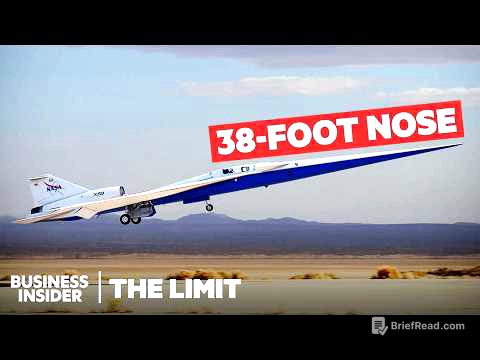TLDR;
This lecture provides an overview of geomorphology, covering endogenic and exogenic processes, weathering, mass movements, and landforms created by various agents like rivers, glaciers, groundwater, sea waves, and wind. It emphasizes the forces that shape the Earth's surface, including both constructive and destructive processes.
- Endogenic processes build up the earth's surface through diastrophism and vulcanicity, driven by internal energy sources like radioactivity and residual heat.
- Exogenic processes wear down the earth's surface through weathering, mass movement, and erosion, driven by external energy sources like the sun.
- Various agents like rivers, glaciers, groundwater, sea waves, and wind create distinct landforms through erosion and deposition.
Introduction to Geomorphology [0:20]
The lecture introduces geomorphology as the study of the Earth's surface and its topography, including the creation and destruction of landforms like mountains. It distinguishes between geology, the study of the Earth's interior, and geomorphology, which focuses on surface features. James Hutton is mentioned as the father of geology.
Endogenic vs. Exogenic Forces [5:03]
The lecture explains that the earth's surface is shaped by two types of forces: endogenic and exogenic. Endogenic forces originate from within the Earth and build things up, while exogenic forces act on the surface and cause wear and tear. The Himalayas and Aravallis are used as examples to illustrate the interplay between these forces. The Himalayas are tall due to prevalent endogenic forces, while the Aravallis are less prominent due to dominant exogenic forces.
Endogenic Processes: Diastrophism and Vulcanicity [7:26]
Endogenic processes are caused by endogenic forces and result in the building up of the earth's surface. These processes include diastrophism and vulcanicity. Diastrophism involves plate deformation, including orogenic movements (mountain building), epeirogenic movements (uplifting of the Earth's crust), and earthquakes. Vulcanicity involves the eruption of magma or lava onto the surface. The lecture also touches on plate tectonics, mentioning convergent, divergent, and transform plate boundaries.
Energy Behind Endogenic Forces [10:05]
The energy behind endogenic forces comes from several sources within the Earth. These sources include radioactivity, which generates convective currents in the asthenosphere, primordial heat (residual heat from the Earth's formation), and tidal forces (rotational or tidal friction). Arthur Holmes is credited with the theory of convective currents.
Exogenic Processes: Denudation [13:45]
Exogenic processes are those that cause wear and tear on the Earth's surface. These processes are carried out by various agents such as wind, glaciers, and water. The primary source of energy for exogenic processes is the sun. Exogenic processes are collectively known as denudation, which includes weathering, mass movement, and erosion/transportation.
Weathering: Types and Processes [15:36]
Weathering is the breaking down of rocks and minerals in situ (without movement). There are three types of weathering: chemical, physical, and biological. Chemical weathering involves processes like solution, carbonation, oxidation, and hydration. Physical weathering involves stress due to temperature changes, pressure, or gravity. Biological weathering involves the action of living organisms, such as earthworms and rodents. Exfoliation, a process where the top layer of rock breaks and falls off due to temperature changes, is discussed as an effect of physical weathering.
Mass Movement: Types and Driving Forces [20:46]
Mass movement involves the movement of a large portion of the Earth's surface due to gravity. Weathering is not a prerequisite for mass movement. The main driving force behind mass movement is gravitational force. There are two types of mass movement: rapid and slow. Rapid mass movements include landslides, avalanches, and mudflows. Slow mass movements include creep and soil flexion. Deforestation is identified as an anthropogenic reason for landslides, as tree roots hold the soil together.
Slow Mass Movement: Soil Flexion and Creep [24:10]
Soil flexion is a slow mass movement that occurs in temperate areas where the bottom layer of soil freezes, causing the upper layer to slide more quickly. Creep is a slow, gradual movement of soil that can cause pillars and poles to tilt over time.
Landforms Due to Various Agents: Introduction [27:23]
The lecture transitions to discussing landforms created by various agents such as rivers, glaciers, wind, sea waves, and groundwater. It is emphasized that this topic is important for exams, and students should read about it in detail from NCERT or other books.
Landforms Created by River Water: Erosional and Depositional [29:52]
Landforms created by river water are categorized into erosional and depositional features. Erosional landforms are created by the river's kinetic energy, which erodes the landscape. Depositional landforms are created when the river deposits sediment. The lecture discusses the three stages of a river: youth full, mature, and old. Youth full stage is dominated by erosion, mature stage involves both erosion and deposition, and old stage is dominated by deposition.
Erosional Landforms of River Water [33:50]
Erosional landforms created by river water include V-shaped valleys, gorges, canyons, waterfalls, entrenched meanders, river terraces, and potholes. A V-shaped valley is a valley with a V-shaped cross-section. A gorge is a narrow valley with steep, rocky walls. A canyon is a deep, narrow valley with steep walls. A waterfall is a place where water flows over a vertical drop. Entrenched meanders are meandering rivers that have cut deeply into the landscape. River terraces are step-like platforms along the sides of a river valley. Potholes are small, circular depressions in the riverbed.
Depositional Landforms of River Water [36:24]
Depositional landforms created by river water include alluvial fans, levees, oxbow lakes, and deltas. An alluvial fan is a fan-shaped deposit of sediment at the base of a mountain. Levees are natural embankments along the sides of a river. Oxbow lakes are crescent-shaped lakes formed when a meander is cut off from the main channel. Deltas are triangular-shaped deposits of sediment at the mouth of a river. Kabar Tal in Bihar is mentioned as one of Asia's largest oxbow lakes.
Delta vs Estuary [42:28]
The lecture briefly explains the difference between a delta and an estuary. Deltas are formed when a river deposits sediment at its mouth, while estuaries are formed when a river flows into the sea without depositing much sediment. The Narmada and Tapi rivers, which flow towards the west, form estuaries because they flow through rift valleys and do not carry much silt.
Landforms Created by Glaciers: Erosional [43:27]
Landforms created by glaciers are categorized into erosional and depositional features. Erosional landforms include cirques, arêtes, horns, and U-shaped valleys. A cirque is a bowl-shaped depression at the head of a glacier. An arête is a sharp ridge between two cirques. A horn is a pointed peak formed by the erosion of several cirques. A U-shaped valley is a valley with a U-shaped cross-section, formed by glacial erosion. Hanging valleys are also mentioned, which are smaller valleys that hang above the main U-shaped valley.
Landforms Created by Glaciers: Depositional [46:08]
Depositional landforms created by glaciers include eskers, drumlins, moraines, and outwash plains. An esker is a long, winding ridge of sediment deposited by a subglacial stream. A drumlin is an oval-shaped hill of sediment deposited by a glacier. Moraines are ridges of sediment deposited along the sides or at the end of a glacier. Outwash plains are flat areas of sediment deposited by meltwater streams flowing from a glacier. Fjords are also mentioned, which are glacial valleys that have been flooded by seawater.
Landforms Created by Groundwater: Erosional and Depositional [48:24]
Landforms created by groundwater are categorized into erosional and depositional features. These landforms are commonly found in areas with limestone and dolomite rock, which are easily dissolved by water. Erosional landforms include sinkholes, dolines, lapies, and limestone pavements. A sinkhole is a depression in the ground formed by the collapse of a cave roof. A doline is a larger sinkhole. Lapies are grooves and ridges formed by the dissolution of limestone. Limestone pavements are large areas of exposed limestone with lapies.
Karst Topography [1:01:46]
The lecture explains that the ground water land forms are called cast topography. The name comes from the Karst region near the Mediterranean Sea in Southern Europe, where these landforms are prominently seen.
Depositional Landforms of Ground Water [51:07]
Depositional landforms created by groundwater include stalactites, stalagmites, and pillars. Stalactites are icicle-shaped deposits that hang from the ceiling of a cave. Stalagmites are cone-shaped deposits that rise from the floor of a cave. Pillars are formed when a stalactite and a stalagmite meet.
Landforms Created by Sea Waves: Erosional [52:10]
Landforms created by sea waves are categorized into erosional and depositional features. The lecture discusses the causes of waves, including wind, tides, and tsunamis. Erosional landforms include cliffs, stacks, arches, and caves. A cliff is a steep rock face along the coast. A stack is a pillar of rock isolated from the mainland. An arch is a natural bridge formed by wave erosion. A cave is a hollow space in a cliff.
Landforms Created by Sea Waves: Depositional [54:44]
Depositional landforms created by sea waves include beaches, dunes, bars, barriers, and spits. A beach is a deposit of sand or gravel along the coast. A dune is a hill of sand formed by wind. A bar is a ridge of sand or gravel that extends across a bay or estuary. A barrier is a long, narrow island that runs parallel to the coast. A spit is a narrow strip of sand that extends from the mainland into the sea. Lagoons are also mentioned, which are bodies of water separated from the sea by a barrier or spit.
Landforms Created by Wind: Erosional and Depositional [56:24]
Landforms created by wind are called aeolian landforms and are mostly found in deserts. The high wind speed and abundance of sand in deserts allow wind to erode and deposit sediment, creating unique landforms. Erosional landforms include mushroom rocks, pedestal rocks, and yardangs. Depositional landforms include playas, sand dunes, barchans, and seifs.
Aeolian Landforms: Mushroom Rocks, Playas and Sand Dunes [57:15]
Mushroom rocks are rocks that have been eroded at the base by wind, creating a mushroom-like shape. Playas are shallow, ephemeral lakes that form in desert depressions. Sand dunes are hills of sand formed by wind deposition. Barchans are crescent-shaped dunes with horns pointing downwind, while seifs are linear dunes with a sharp crest.
Review Questions [59:48]
The lecture concludes with a series of review questions covering the topics discussed. These questions test the students' understanding of geomorphology, including the definition of terms, the processes involved in landform creation, and the agents responsible for shaping the Earth's surface.









